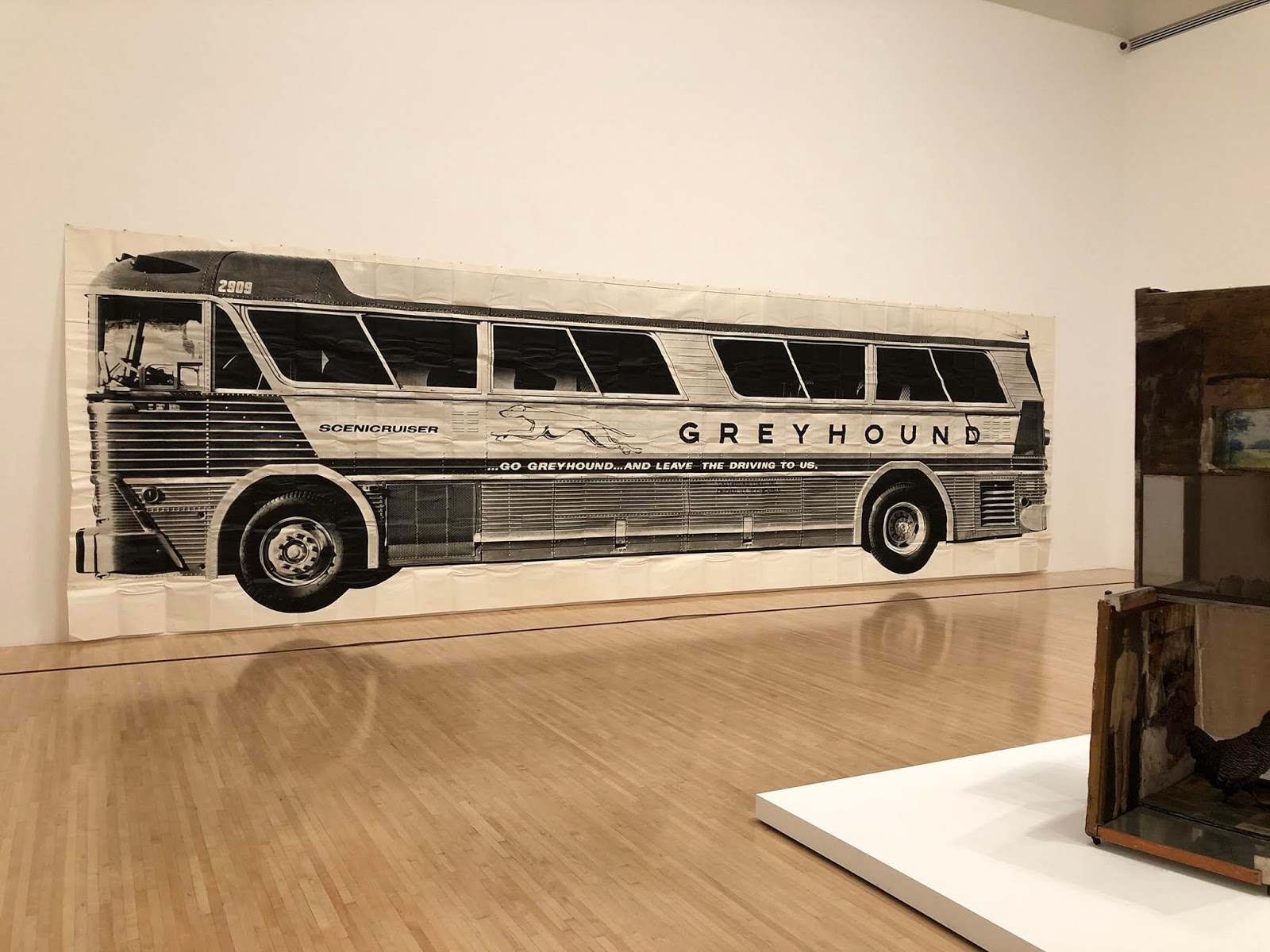 |
| Mason Williams' Bus, 1967, with Robert Rauschenberg's untitled Combine, about 1954 |
MOCA's latest permanent-collection install starts with a bang: Mason Williams'
Bus (1967). It's the biggest work by the least known artist in a room that spans Robert Frank, Louise Nevelson, Robert Rauschenberg, and Betye Saar.
Bus is a life-size (37-feet wide) photograph of a bus. More exactly, it's silkscreen of a photograph (by Max Yavno), folded like a printed road map to fit into a compact box. Williams is or has been a poet, stand-up comedian, TV comedy writer (
The Smothers Brothers Comedy Hour,
Saturday Night Live), and composer of
Classical Gas, said to be the most popular instrumental of the radio age. Williams was also a childhood friend and occasional collaborator of Ed Ruscha. As a concept,
Bus is something like Ruscha's
Every Building on the Sunset Strip (1966)—only more so. Williams self-published
Bus and sold it for $30, edition of 200. It was shown at the Pasadena Museum of Art and MoMA shortly after its creation, and featured in
Life magazine. Famous but not always taken seriously,
Bus has lately been reappraised as one of the most audacious works of 1960s Cali-Conceptualism.
Bus anchors the first of seven rooms in "Seven Stations: Selections from MOCA's Collection," organized by Mia Locks and Bennett Simpson with Karlyn Olvido. The rooms range from the museologic traditional (a white cube of Rothko paintings) to provocative juxtapositions across time and sensibility. MOCA has done this sort of thing from its inception, but for some it will invite comparison to new MoMA (or future LACMA).
 |
| Terry Adkins, Forst Mosaic, 1997 |
The second room has two large found-object assemblages, both new acquisitions, by Terry Adkins and Nari Ward. The Adkins is made from tags used for a brand (Forst) of pork sausages. It's a van Gogh sunflower gone to seed, and oblique political commentary ("Forst" = "forced"?)
 |
| Carlos Cruz-Diez, Chromosaturación, 1965 |
That's followed by the late Carlos Cruz-Diez's Chromosaturación (1965), a room-sized installation jointly owned with the Hirshhorn. That in turn leads to a Rothko mini-chapel exploring the power of juxtaposed color in a completely different way.
 |
| Mark Rothko paintings |
 |
| Beverly Pepper's Untitled Stainless Steel, 1963; Ruth Asawa's Untitled (Hanging, Two Lobed, Interlocking Continuous Forms Within Forms), about 1955; and Richard Serra's Untitled Trapezoid, 1976 |
A room of metal sculpture turns out to be a mediation on gender and minimalism. Serra, the lone male/minimalist, seems dull next to the curves and wit of Ruth Asawa, Beverly Pepper, Yoko Ono, and Liz Larner. There are also two fantastic drawings, by Nancy Rubins and Judith Bernstein.
 |
| Liz Larner, You might have to live like a refugee, 2019 |
The final room is a dark cube of early video art debuting new acquisitions by Dan Graham, Joan Jonas, Bruce Nauman, Nam June Paik, and Martha Rosler. Rosler's
Semiotics of the Kitchen draws on Julia Child, women's oppression, and the implicit violence of kitchen utensils.
 |
| Martha Rosler, Semiotics of the Kitchen, 1975 |







Comments
What's going on? Hints of some of the financial issues that struck the Marciano?
Then there's the irresponsbile nature of Michael Govan and his people.